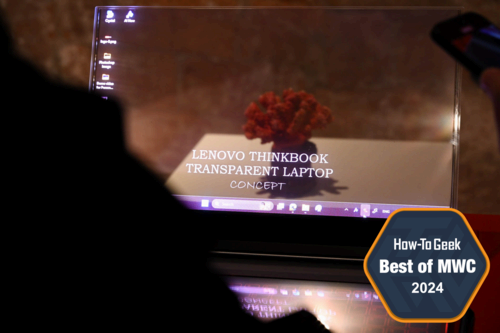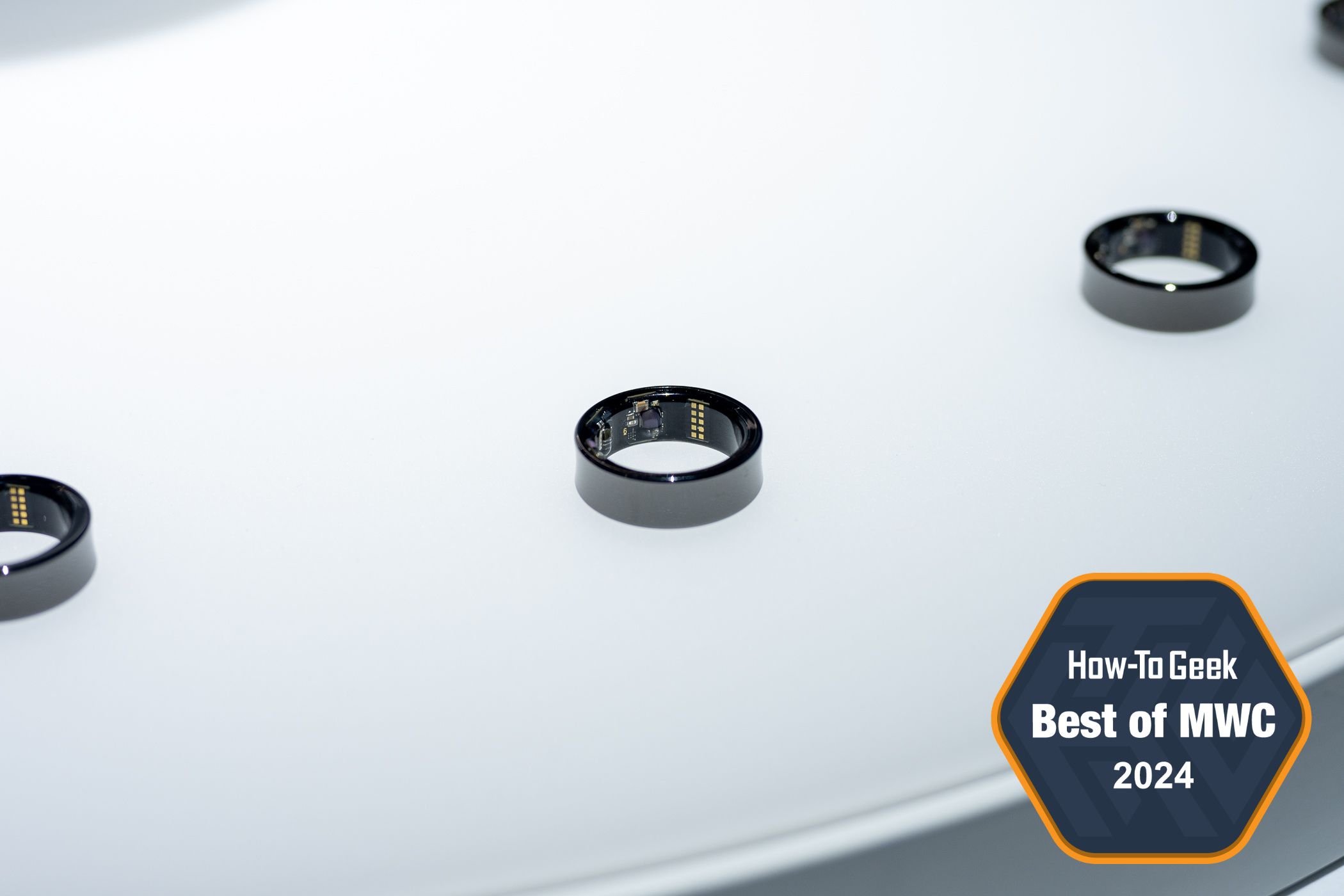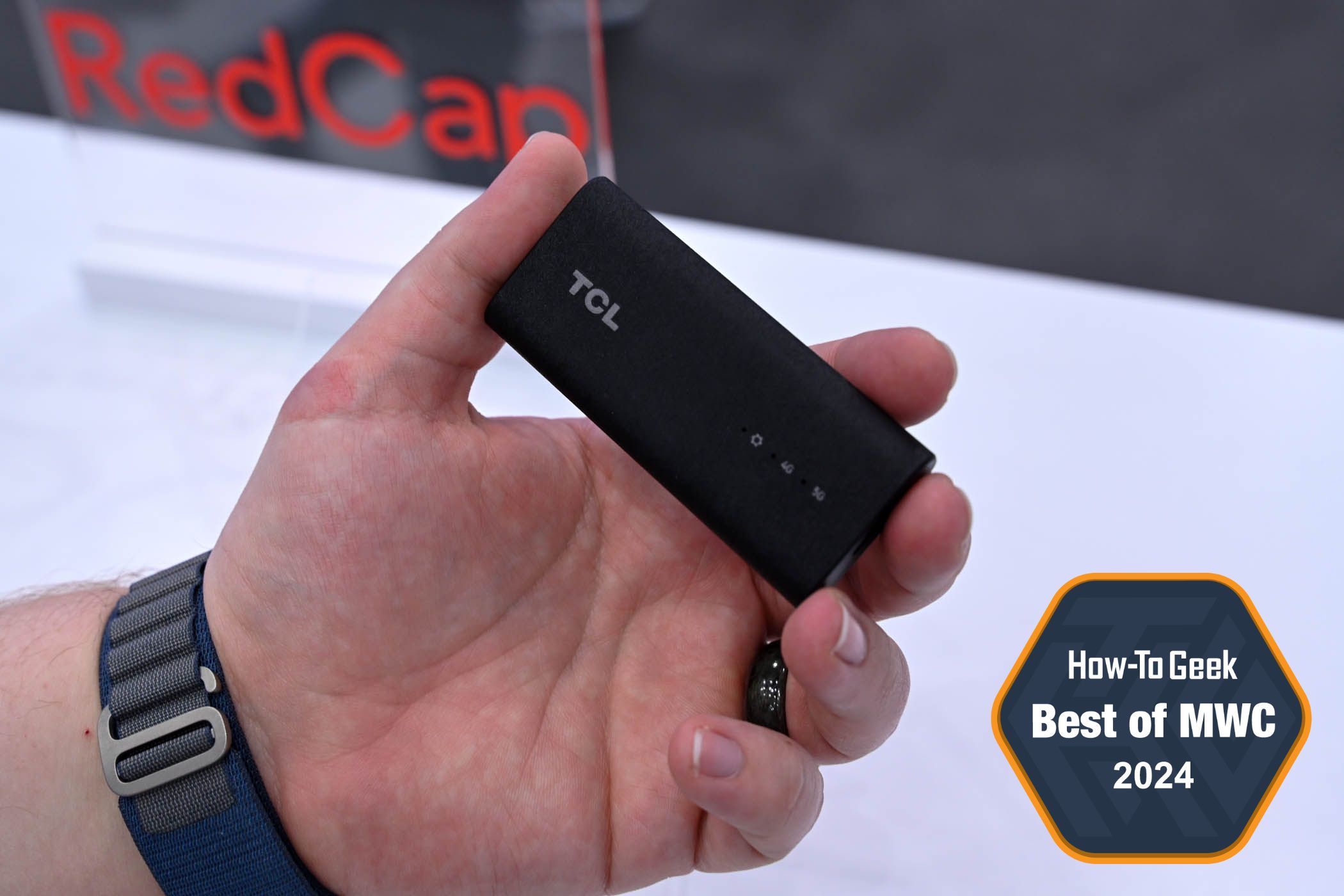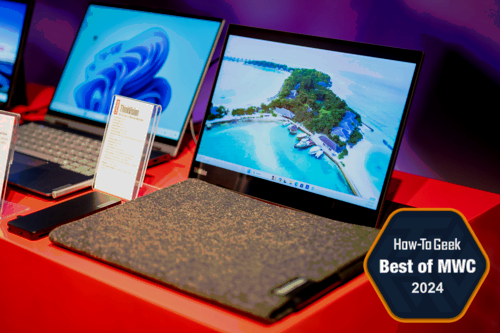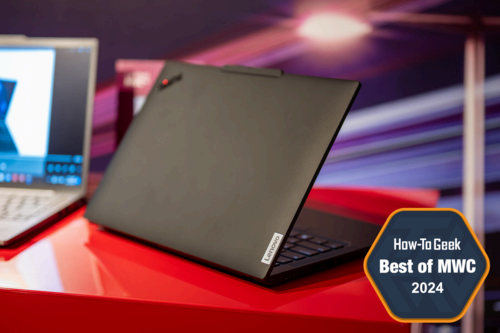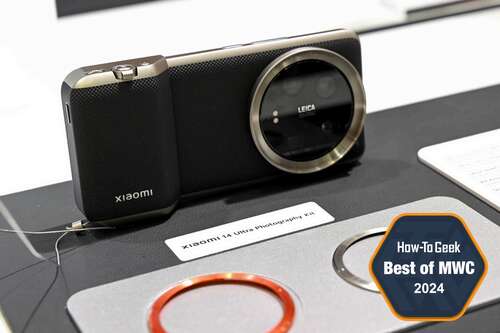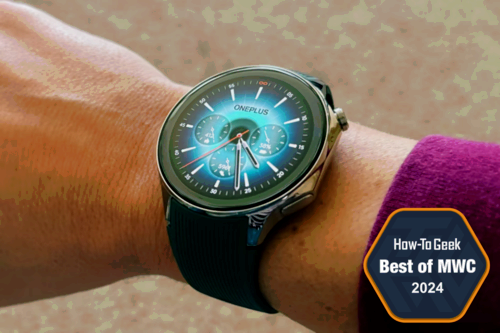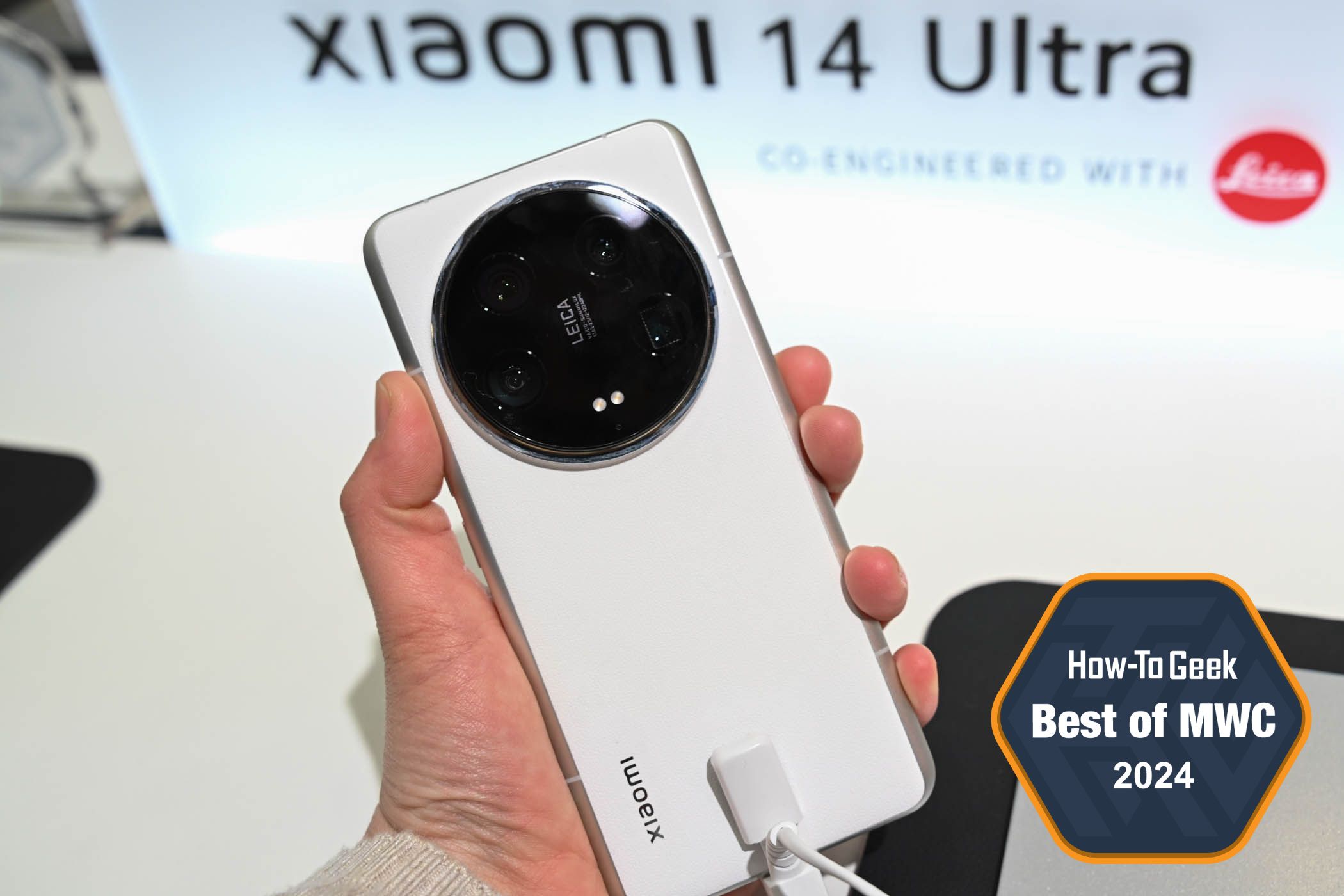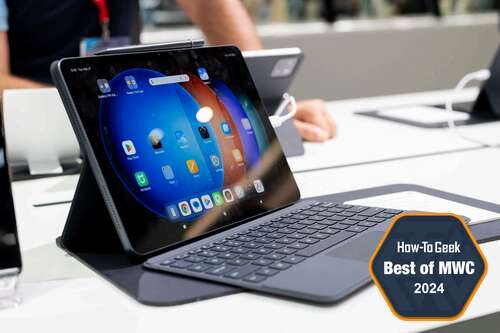Spring feels like it may finally be just around the corner, and in the tech world, that means Mobile World Congress. We’ve got feet on the ground in Barcelona checking out all the cool products from MWC 2024. Here are 10 of our favorites from the big show.
Best Concept: Lenovo Project Crystal Laptop
While it isn’t a product you can buy, the Lenovo ThinkBook Transparent Display Laptop (otherwise known as “Project Crystal”) made an undeniably dramatic impression on us at MWC. Its edge-to-edge transparent display is also cinematic, evoking those see-through panels ubiquitous to sci-fi and superhero movies.
The 17.3-inch Micro LED panel isn’t just for aesthetics, though, according to Lenovo. The intended user seems to be creative people, as you’re meant to put physical objects behind the screen and use the visibility to sketch drawings onto the panel. According to Lenovo, there’s some amount of automation and interaction possible, too, citing the ever-present specter of AI as the means for this.
The laptop’s base is transparent too, though that part seems less likely to exist still if and when the Lenovo Crystal becomes a real product. A completely flat and smooth surface isn’t ideal for keyboard typing, cool as it may look. We’re interested to see what, if anything, the Lenovo Crystal concept evolves into.
Most Anticipated: Samsung Galaxy Ring
The Galaxy Ring is one of Samsung’s most anticipated products, and with good reason. Imagine a health- and sleep-tracking device, only one that’s far smaller than a Fitbit or Galaxy Watch. Instead, it all fits right on a finger in a lightweight and stylish form factor.
If Samsung’s upcoming Galaxy Ring can monitor your heart rate, body temperature, and movement, it’ll be great for wearing at night. Then, add in fitness tracking, Samsung Pay support, and potentially two-factor authentication features, along with Samsung’s promised AI goodies, and it’s poised to be a popular accessory when it arrives later this year.
Best Networking: TCL LINKKEY IK511
Now that 5G internet is readily available across the United States, hardware manufacturers are faced with the challenge of building next-gen 5G devices and modems. And TCL’s new LINKKEY IK511 adapter is just such a device. It’s small enough to fit in your pocket, yet it adds 5G connectivity to any laptop or tablet.
Revealed at MWC 2024, the TCL LINKKEY IK511 is a RedCap or “reduced capability” 5G modem. It’s one of the first portable modems to leverage Qualcomm’s Snapdragon X35 5G Modem-RF system, and it’s small enough to fit in your pocket.
The RedCap standard aims to deliver 5G connectivity with minimal power consumption. There’s just one tradeoff, and it’s fairly minor—RedCap devices are limited to 150Mbps download speeds and 50Mbps upload speeds. It’s faster than public Wi-Fi, but it’s a bit slower than the average home internet speed.
Devices like the TCL LINKKEY IK511 will greatly increase the availability of mobile networking, particularly for laptops. And because this is a RedCap modem, rather than a full-fat 5G mobile hotspot (such as the NETGEAR Nighthawk M6), it will cost less than $100 at launch.
TCL says that the LINKKEY IK511 will arrive in the United States around Q3 2024. Unfortunately, we don’t have an exact price, and TCL hasn’t revealed which carrier it’s working with.
Working from a laptop can feel limiting if you’re used to multiple monitors or ultrawide screens at home, but some portable monitors can give you more space while traveling. Lenovo revealed a new portable display at MWC that looks like a fantastic productivity tool: the ThinkVision M14t Gen 2 Mobile Monitor (Touch).
The ThinkVision M14t is a 14-inch portable monitor with a 16:10 aspect ratio, which you can plug into any computer with USB-C display support. It can tilt from -5° to 90° and only weighs 1.5 pounds (0.7 kilograms). The IPS screen has a resolution of 2240×1440, a brightness of 300 cd/m2, a 1500:1 contrast ratio, and 100% sRGB support. It’s also a full touch screen.
Between the slim design, USB Type-C passthrough for power and data, and touchscreen functionality, the ThinkVision M14t seems like a compelling device for on-the-go productivity. Lenovo says it will be available starting in July 2024, with an expected starting price of $399.
Best Laptop: Lenovo ThinkPad T14 Gen 5 and T16 Gen 3
The right-to-repair movement has increased in pace and victories in recent years, and Lenovo has embraced it with the ThinkPad T14 Gen 5 and T16 Gen 3. Regardless of which model you choose, you get the ability to change out your memory, storage, battery, or Wi-Fi and Bluetooth adapter with minimal fuss. Lenovo prints visual indicators on the device and also provides guides to walk you through repairs, so you don’t have to be a tech whiz just to do a basic upgrade.
Of course, you won’t have to upgrade any time soon with the configurations that will be available when the laptops go on sale in April. They operate on Intel’s latest Core Ultra platform, they use DDR5 RAM, and you can get the latest wireless standard Wi-Fi 7 or 5G connectivity. On release, the T14 Gen 5 will go for as low as $949, and the larger, more powerful T16 Gen 3 will be $1,219.
Best Accessory: Xiaomi 14 Ultra Photography Kit
Everything old is new again eventually, and cellphone accessories are no exception. Nowhere is this more apparent than with the Xiaomi 14 Ultra Photography kit, which functionally converts the flagship device into a very sleek point-and-shoot camera.
The grip is the most striking part of the entire kit and connects to the phone via USB-C. It features a physical button that can be used to trigger the phone’s shutter or autofocus, a zoom lever, another physical button to trigger video recording, and a dial that can be assigned to control ISO, aperture, shutter speed, or other functions. The grip also conceals a 1,500mAh battery to prevent the phone from being drained while you’re snapping photos. Critically, the grip provides a much better way to hold your phone while you’re snapping photos, especially if you’re shooting in landscape.
The 67mm filter adapter ring is a great addition for photography enthusiasts. Digital photography—especially if you’re shooting RAW format—provides you with a ton of flexibility, but physical filters are a handy option if you’re looking to produce photographs (or video) with a specific aesthetic. They might also protect your phone’s camera array from scratches, though that is not their primary function.
The entire setup looks good. The grip and case, with their leather and metal appearance, are more reminiscent of film SLRs than digital point-and-shoot cameras of the early 2000s. The Xiaomi 14 Ultra’s enormous camera array doesn’t even stand out that much—it looks quite natural. The Xiaomi 14 Ultra Photography kit is available now for $200.
Best Wearable: OnePlus Watch 2
The OnePlus Watch 2 was formally announced at MWC, but we already had it on our wrists for review. The watch runs on Wear OS 4 and features a sleek, premium design that mirrors the OnePlus 12 phone series. It has a stainless steel body and a sapphire crystal watch face, which curves on the edges for a smooth look. It comes in two colors: Black Steel and Radiant Steel, with the latter having a green strap that matches the OnePlus 12’s Emerald color.
Like the Pixel Watch 2, the OnePlus Watch 2 is powered by the Snapdragon W5 Gen 1 chip. The watch can last up to 100 hours in Smart Mode, which balances the use of apps and background activities. It also supports 7.5W VOOC fast charging, which can fully charge the watch in one hour. In our review, Tyler liked Smart Mode and fitness features but wasn’t impressed with the design and charger. Still, it’s nice to have more competition in the Wear OS space.
Best Smartphone: Xiaomi 14 Ultra
The Xiaomi 14 Ultra is a new flagship smartphone, which was unveiled at the MWC, from the Chinese tech giant Xiaomi. The phone boasts a powerful Qualcomm Snapdragon 8 Gen 3 processor, a massive 12GB or 16GB of RAM, and up to 1TB of storage. It also has a stunning 6.73-inch AMOLED display with a resolution of 3,200×1,440 and no curved edges.
One of the most impressive features of the Xiaomi 14 Ultra is its quad-camera setup, which consists of four 50MP sensors, each serving a different purpose. The 50MP main camera has a large aperture of f/1.6 and optical image stabilization, the 50MP ultra-wide camera has a 122° field of view, and the two 50MP telephoto cameras offer 3.2x and 5x optical zoom. The phone also has a 32MP selfie camera on the front and supports 8K video recording, HDR10, and night mode. The Xiaomi 14 Ultra will first be available in China but later launch in the rest of the world (not the US).
Best Tablet: Xiaomi Pad 6S Pro
The Xiaomi Pad 6S Pro is a new flagship Android tablet announced at MWC. It features a massive 12.4-inch 2,032×3,048 LCD display with a 144Hz refresh rate, a Snapdragon 8 Gen 2 processor, and a 10,000mAh battery with 120W fast charging. Xiaomi is positioning this tablet as an iPad Pro alternative—a tablet that can replace a laptop.
The tablet comes with a metal unibody design, a 50MP main camera, a 32MP selfie camera, and a six-speaker stereo sound setup. It runs on HyperOS, a custom skin based on Android 14, which offers cross-device collaboration and Xiaomi Smart Hub features. The tablet also has optional accessories, such as the Touchpad Keyboard and the Focus Pen, which enhance the productivity and creativity of the users. The Xiaomi Pad 6S Pro is priced at €700 for the base model and €800 for twice the storage.
Best Use of AI: Google Gemini Summarization
Summarizing long chains of text, images, and messages is still one of the best use cases for generative AI technology. Google revealed a few improvements coming to Android and Android Auto at MWC, powered by the company’s Gemini AI model.
Android Auto will soon automatically summarize long texts or busy group chats while you’re driving, which should help cut down on distractions—the full texts are still on your phone for whenever you can safely read them. Android Auto will also suggest relevant replies and quick actions, like a button for sharing your ETA when someone asks when you will arrive.
Google’s Lookout app uses your phone’s camera to read documents and describe images. Google announced that the app now has AI-generated captions for photos, online images, and pictures included in messages. You can download Lookout for free from the Google Play Store, but image captions are currently limited to English.
